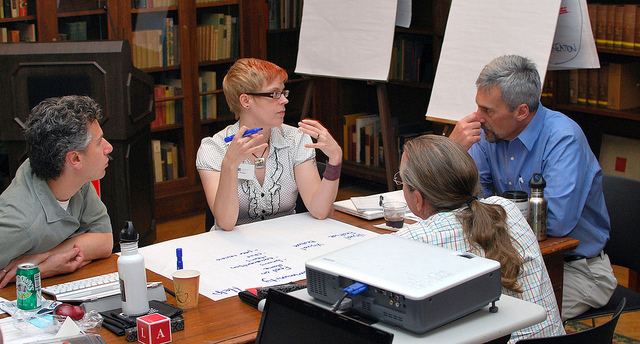The Digital Public Library of America initiative, launched in 2010, held a workshop of their Audience and Participation Workstream on July 27, 2012 at the Enoch Pratt Free Library. The DPLA is a national initiative that aims to create a digital library resource where anyone can search for books, audio, images, and every kind of media, from sources all over the country, all in one place. It aims to provide creative tools to enhance use of the content, for example, to create annotations and curated resource lists, as well as a community platform for researchers, students, experts, and learners of all backgrounds can share their findings and exchange ideas.
About 25 innovative thinkers from across the country worked together to identify functionality that the DPLA will need to have in order to meet the needs of its users. The workshop was very productive, and I am grateful for the opportunity to contribute my thoughts on homepage and application design during the small-group breakout sessions.
Audience and Participation co-chair Nate Hill of the Chattanooga Public Library prepared stories, or use cases, for a set of hypothetical DPLA visitors, describing the kinds of research and sharing they might want to do. Use cases are a common tool used by software developers to try and understand how real people will interact with a product, and to try to anticipate the user needs during the early phases of development. You can view and comment on the DPLA front-end use cases at http://dp.la/use-cases/#.
The group dove in by approaching each hypothetical user individually and by sorting them into categories based on the kinds of work they want to do. Participants envisioned the DPLA as a space for performing research at a variety of levels, for the addition of user-generated content, and for community participation and exchange. Different tasks draw on each of these spaces in different ways, and the discussion allowed us to think about specific functionality that will inform the work of the DPLA’s Technical Aspects Workstream.
We tackled the functionality question by considering what kind of interface a visitor would need to interact with in order to complete a given task. For example, “Darla Jefferson” is an expert on historical boat building and restoration, and she was looking for high resolution images of boat design plans from around the world, representing different historical periods. Using the application we sketched out, she was able to find the images, annotate them, and share and discuss them with other experts in her field.
When the DPLA is launched next year, it will represent a massive leap forward for the advocates of free and open access to information. With the participation of partner institutions from across America, every person will have the ability to find documents, objects, records, music, images, and more from one site, using state-of-the-art technology.
